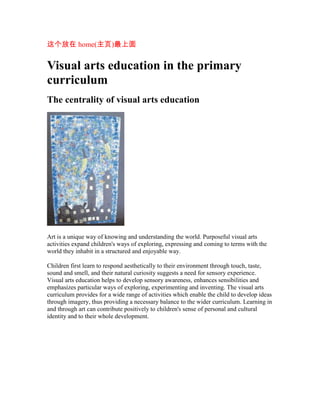Recommended
Recommended
When we're kids, any time is a great option for a little bit of expansion and study. Amidst the laughter, curiosity, and boundless imagination, lies a profound truth: expressive forms and creative opportunities are emerging as major forces that influence child growth and development in Preschool Whittier CA.
https://primantimontessoriacademy.com/Nurturing Young Minds: The Impact of Creative Expression on Early Childhood D...

Nurturing Young Minds: The Impact of Creative Expression on Early Childhood D...Primanti Montessori Academy
More Related Content
Similar to Arts of education
When we're kids, any time is a great option for a little bit of expansion and study. Amidst the laughter, curiosity, and boundless imagination, lies a profound truth: expressive forms and creative opportunities are emerging as major forces that influence child growth and development in Preschool Whittier CA.
https://primantimontessoriacademy.com/Nurturing Young Minds: The Impact of Creative Expression on Early Childhood D...

Nurturing Young Minds: The Impact of Creative Expression on Early Childhood D...Primanti Montessori Academy
Similar to Arts of education (20)
Unveiling the Rich Tapestry of Advantages in Art Lessons for Kids.docx

Unveiling the Rich Tapestry of Advantages in Art Lessons for Kids.docx
Beyond the Crayon Exploring Creative Arts in Preschool Curriculum

Beyond the Crayon Exploring Creative Arts in Preschool Curriculum
Why art is important in early childhood | Abrakadoodle

Why art is important in early childhood | Abrakadoodle
Art Integrated Learning PPT by Dr Sarvesh Mourya NCERT

Art Integrated Learning PPT by Dr Sarvesh Mourya NCERT
Importance of art, imagination and creativity in your child’s life

Importance of art, imagination and creativity in your child’s life
Nurturing Young Minds: The Impact of Creative Expression on Early Childhood D...

Nurturing Young Minds: The Impact of Creative Expression on Early Childhood D...
How Sensory Activities Enhance Learning for Children.pptx

How Sensory Activities Enhance Learning for Children.pptx
Art Lessons Help Children To Think And Express Themselves Clearly

Art Lessons Help Children To Think And Express Themselves Clearly
The Importance of Best Creativity Play School In Delhi.pdf

The Importance of Best Creativity Play School In Delhi.pdf
Holistic Learning Embracing Arts and Sciences in Italian Schools.pdf

Holistic Learning Embracing Arts and Sciences in Italian Schools.pdf
How Does Learning Happen - Artifact and reflective narrative

How Does Learning Happen - Artifact and reflective narrative
Benefits of Art and Craft Workshops in Child Development.pptx

Benefits of Art and Craft Workshops in Child Development.pptx
Sadhana Infinity International Schools in Hyderabad

Sadhana Infinity International Schools in Hyderabad
Visual Arts Education - its important role in Shaping Personality by Theodora...

Visual Arts Education - its important role in Shaping Personality by Theodora...
Arts of education
- 1. 这个放在 home(主页)最上面 Visual arts education in the primary curriculum The centrality of visual arts education Art is a unique way of knowing and understanding the world. Purposeful visual arts activities expand children's ways of exploring, expressing and coming to terms with the world they inhabit in a structured and enjoyable way. Children first learn to respond aesthetically to their environment through touch, taste, sound and smell, and their natural curiosity suggests a need for sensory experience. Visual arts education helps to develop sensory awareness, enhances sensibilities and emphasizes particular ways of exploring, experimenting and inventing. The visual arts curriculum provides for a wide range of activities which enable the child to develop ideas through imagery, thus providing a necessary balance to the wider curriculum. Learning in and through art can contribute positively to children's sense of personal and cultural identity and to their whole development.
- 2. The visual arts in a child-centered curriculum Each child possesses a range of intelligences and he/she needs a variety of learning experiences in order to develop them fully. Visual arts activities enable children to make sense of and to express their world in visual, tangible form. They can also be unifying forces in children's learning and development: drawing, painting, inventing and constructing bring together different elements of children's experience from which a whole new experience can develop. Understanding visual imagery opens additional ways of learning for children and enables them to record real or imagined ideas and feelings. Opportunities to explore and investigate the visual elements in their environment help them to appreciate the nature of things and to channel their natural curiosity for educational ends. The confidence and enjoyment that stem from purposeful visual arts activities can have a positive effect on children's learning in other areas of the curriculum. Children who have had experience in exploring and experimenting with a variety of art materials and media are likely, as they develop, to produce art that is personal. A quality visual arts programme ensures that each child has a variety of enriching visual arts experiences in both two- and three-dimensional media.

